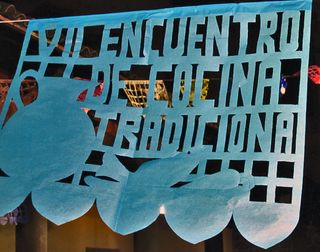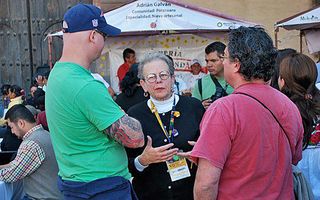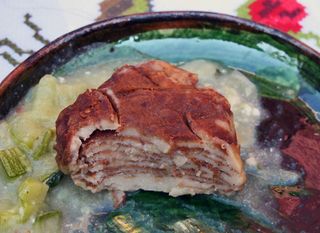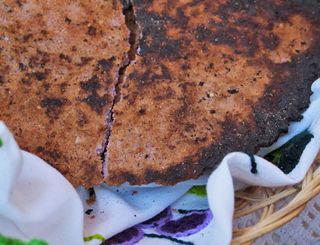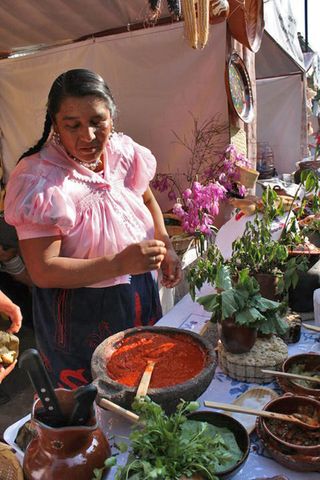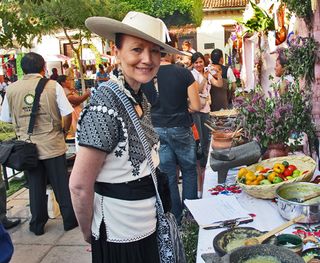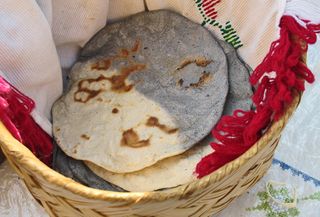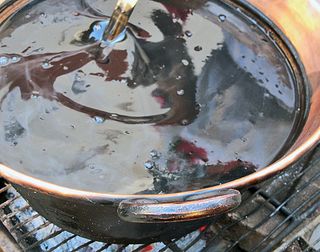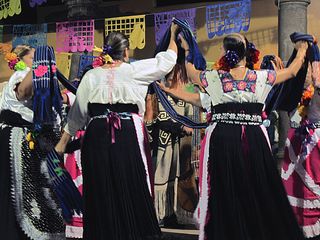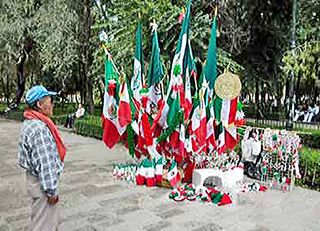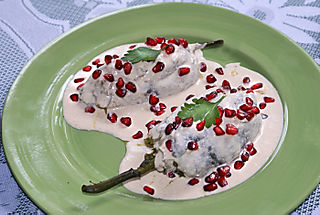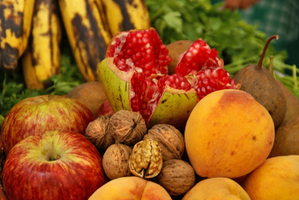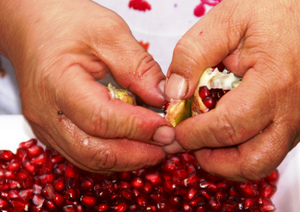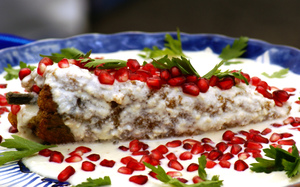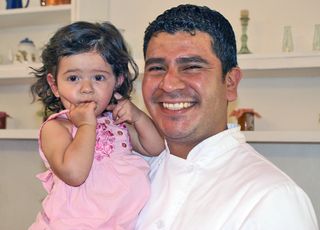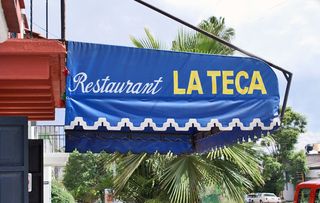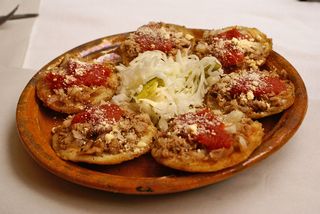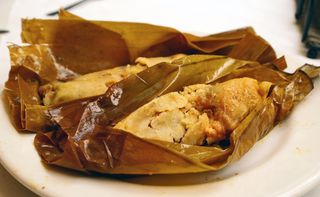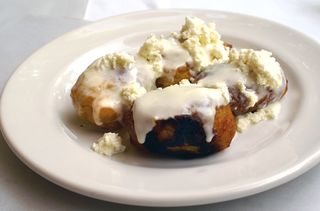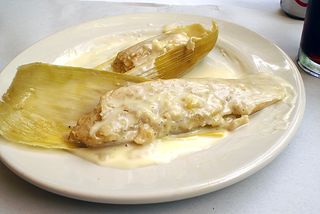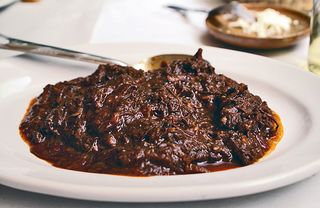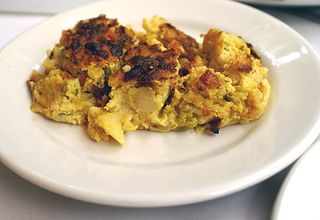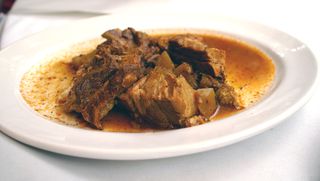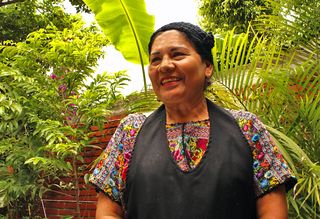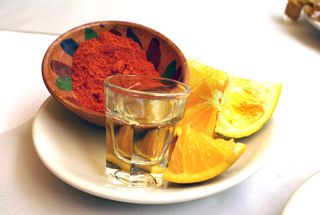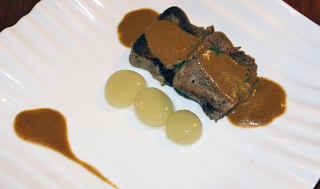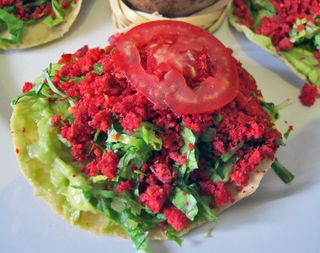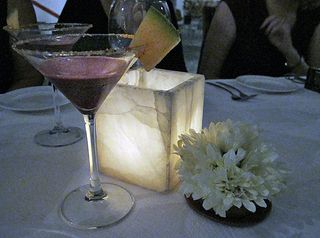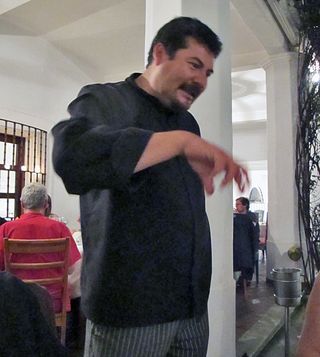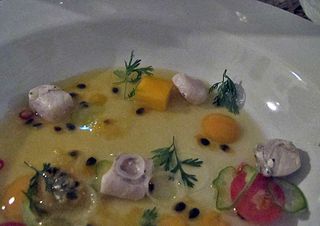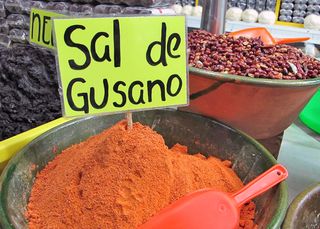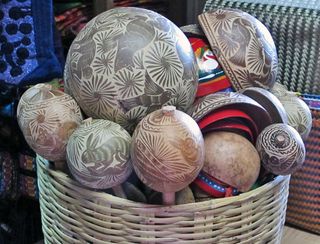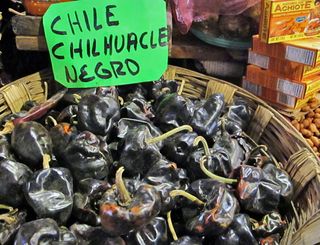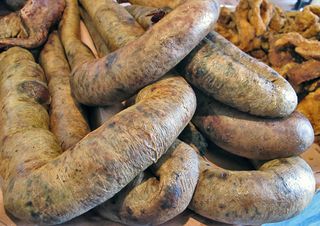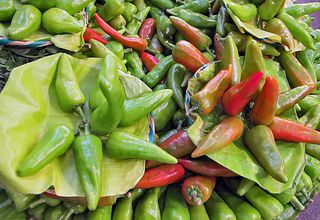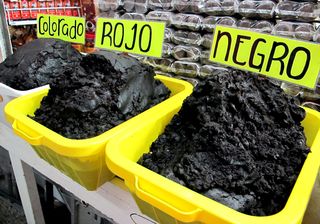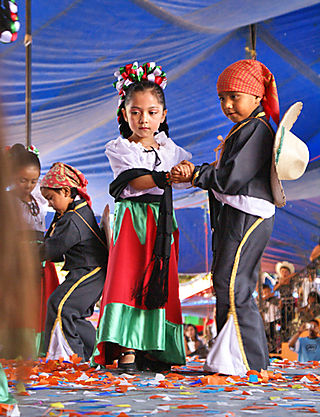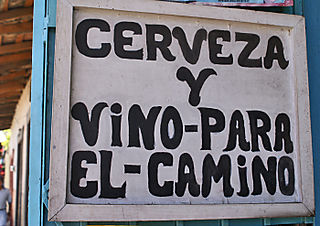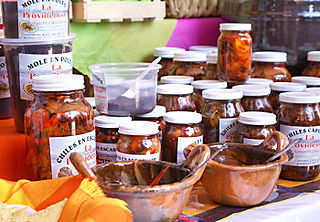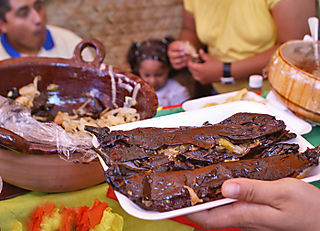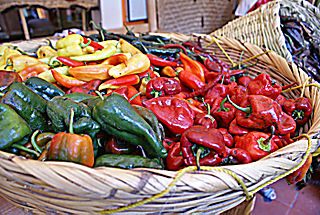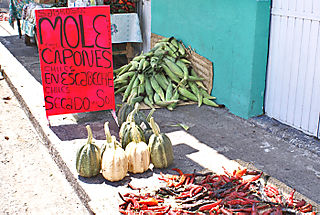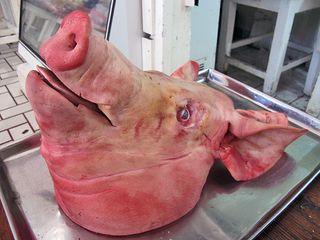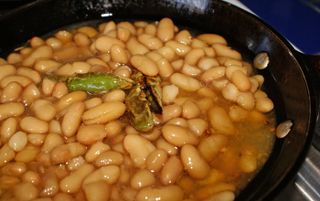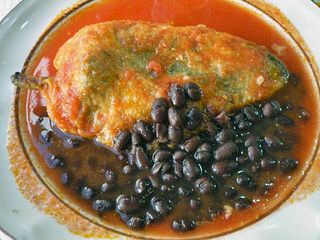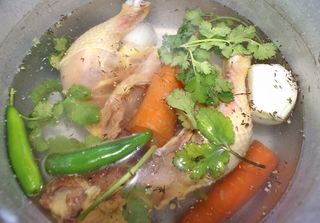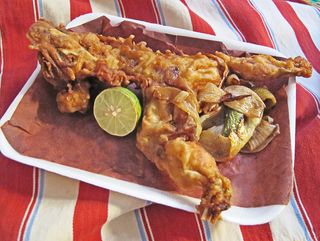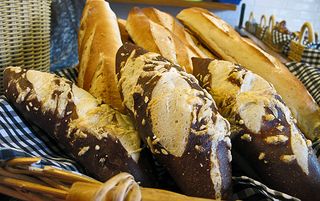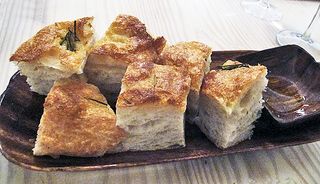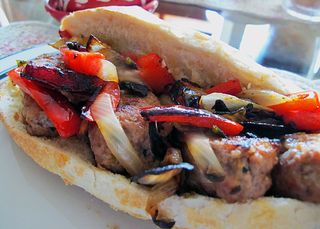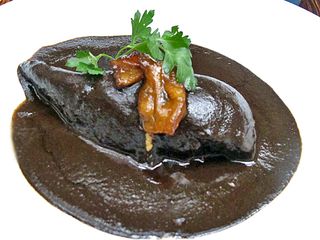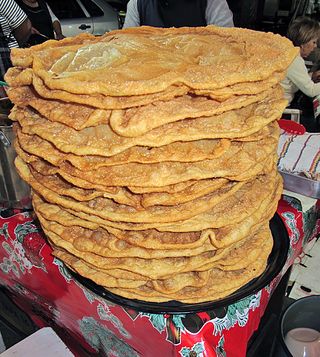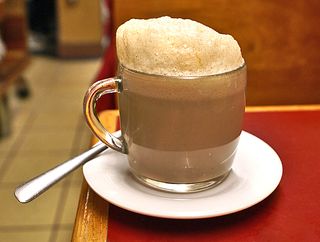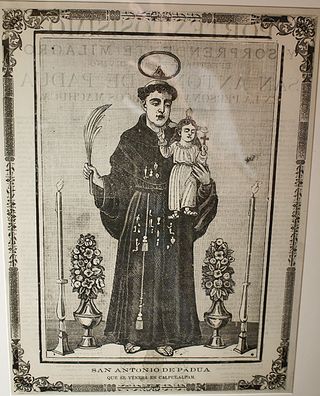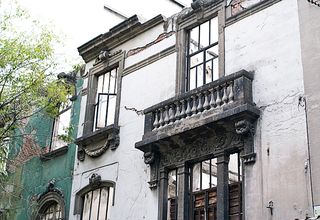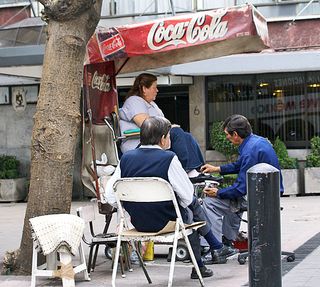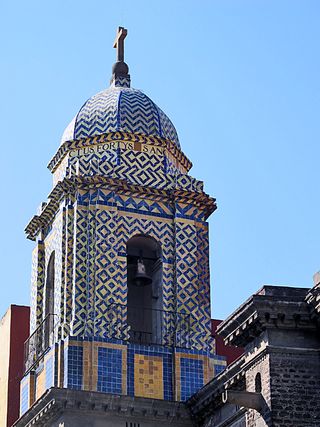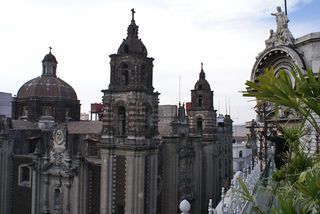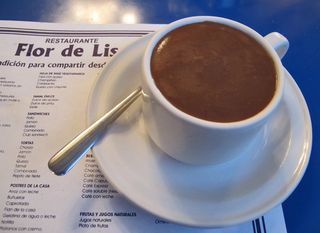On October 4, 5, and 6, 2013, the Encuentro de Cocina Tradicional de Michoacán
will celebrate its 10th anniversary. In honor of the coming festival,
for the next three weeks, Mexico Cooks! will publishing its articles
about the prior three years of the Encuentro. In mid-October, you'll find the report of the 10th Anniversary Encuentro,
right here on Mexico Cooks!. And if you can possibly get to the 10th
Anniversary event, we'll publish all the details just as soon as we have
them. Meantime, save the dates: October 4, 5, and 6, 2013 in Morelia,
Michoacán.
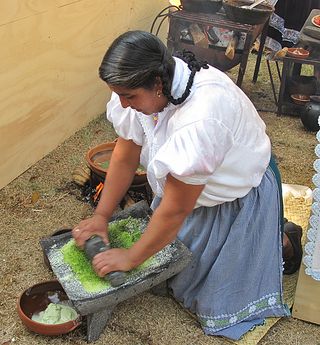
Maestra Benedicta Alejo Vargas grinds cilantro and mint to prepare tzirita, a deliciously spicy botana (appetizer or snack) based on metate-ground chile seeds and various herbs.
For me, the days leading to the Eighth Annual Encuentro de Cocina
Tradicional de Michoacán moved almost as slowly as the days leading to a
five-year-old's Christmas morning. This event celebrating the
traditional cuisines of regional Michoacán, held annually during the
first weekend of December, is the high point of my personal and
professional year.
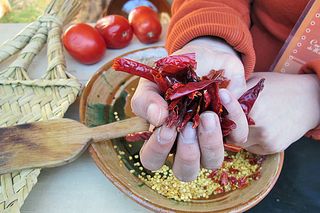
Essentials of the Michoacán kitchen: clay pots, wooden utensils, a ventilador (fan) to urge the wood fire hotter, and the skilled hands of a cook.
The Encuentro started life in 2004, sponsored by the Secretaría de Turismo and the Secretaría de Cultura del Estado de Michoacán
as well as by several generous corporate sponsors. During its eight
years, it has grown and changed, evolving into the unique event that so
many of us enjoy. Although there are many different food festivals in
Mexico, no other has the impact of the annual Encuentro.
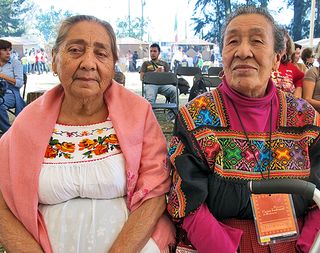
Maestra Amparo Cervantes (left) of Tzurumútaro and Señora Paulita Alfaro of Nuevo San Juan Parangaricutiro are two of several elegant and vital grandes damas
(great ladies) of the Michoacán kitchen. They pass their recipes and
secrets of the kitchen to their daughters and granddaughters.
In November 2010, UNESCO
(the United Nations Educational, Scientific, and Cultural
Organization) announced that Mexico, and particularly the state of
Michoacán, had been officially inscribed on the Representative List of
the Intangible Cultural Heritage of Humanity. Since then, Michoacán
regional cooks have proudly carried the banner of what is called el paradigma michoacano–the
Michoacán paradigm. UNESCO included those words in its award based on
miliennia-old indigenous Purhépecha way of food preparation that has
been preserved, protected, and promoted up to the present day. The
Michoacán paradigm is a model for other regional Mexican cuisines.

Freshly hand-made corn tortillas toasting on a wood-fire heated clay comal
(griddle). Note that the tortilla in the foreground is puffed up; this
is a key sign of a properly made tortilla. The tortilla will flatten
out again as it toasts. There are no tortillas like those hand-made in
Michoacán.
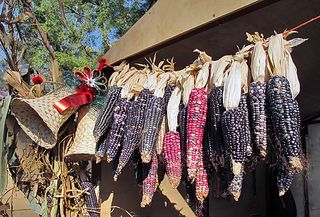
Much
of Michoacán's regional cuisine is based on Mexico's native corn.
These dried ears, hung up to decorate a festive food stand at the 2010 Encuentro, show just a few of the several colors of corn native to this area. The preservation of native corn varieties is crucial to the continuity of the Michoacán paradigm.
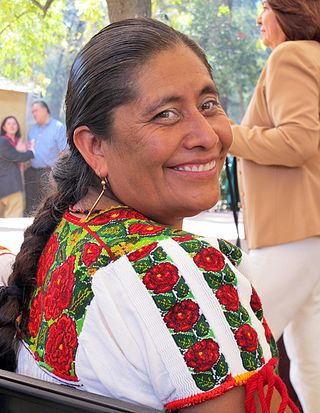
Maestra Antonina González Leandro of Tarerio, Michoacán, is radiant in her hand-embroidered blouse.
This year, the organizing committee gave special honors to a few of
the consistent winners of the cooking competition at the heart of each
annual Encuentro. These great women of the regional kitchen, now retired from competition, are the soul of this festive event. They are:
- Benedicta Alejo Vargas, San Lorenzo. Her specialities for 2010 were wild mushrooms, traditional churipo (a beef-based soup), rabbit mole, cheese mole, and tzirita.
- Juana Bravo Lázaro, Angahuan. Her specialities were atápakua de kuruchi kariri (dried fish stew), filled corundas with churipo, and two varieties of tortillas.
- Antonina González Leandro, Tarerio. She specialized in fried trout with traditional mole, tomato mole, or in a broth, pozole, and ponteduro (a kind of toasted and sweetened corn snack).
- Esperanza Galván Hernández, Zacán. Her specialties were mole tatemado con arroz (baked mole with rice), quesadillas, corundas filled with vegetables, and blue corn tortillas.
- Amparo Cervantes, Tzurumútaro. For this Encuentro, she specialized in mole con pollo y arroz (mole with chicken and rice), carne de puerco con rajas (pork meat with poblano chile strips), corundas, and uchepos.
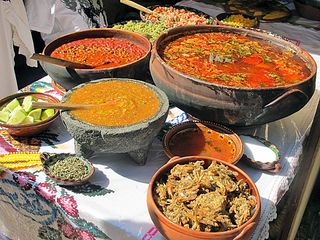
A few of Maestra Antonina's special dishes, including (lower right) tortitas de charales, (center, in the molcajete) salsa de chile perón, (back left) nopalitos en salsa de jitomate, and (back right) caldo de trucha (freshly fried Michoacán-farmed rainbow trout in broth).
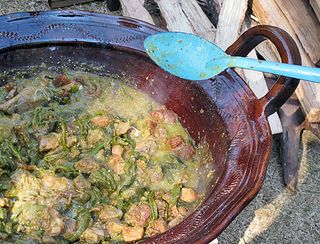
Maestra Amparo's carne de cerdo con rajas, cooking over a wood fire. She constantly tended and stirred the cazuela (clay cooking dish) so that the preparation would neither dry out nor stick.
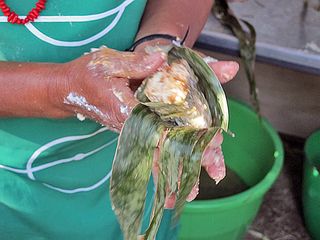
Sra. Cayetana Nambo Rangel of Erongarícuaro prepared choricorundas, a type of pyramid-shaped corn tamal filled with cooked chorizo, a spicy pork sausage. The corunda is wrapped in a long green corn leaf (not a corn husk) and then steamed. Traditionally, corundas can be either blind (made without a filling) or filled.
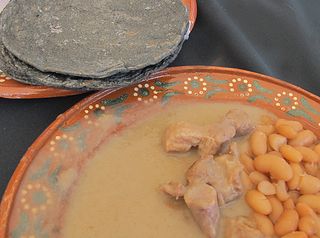
Young cook Susana Servín Galván of Zacán entered the food competition with cuchiatápakua en chile verde con frijoles de la olla, a traditional dish from her small town. The dish consists of pork meat cooked in a thick sauce made of highly spicy chile serrano
and served with freshly cooked beans and blue corn tortillas. This is
my jealously guarded plateful; the dish was stunningly delicious and
sold out quickly. I was lucky to taste it.

Susana Servín Galván, the up-and-coming young cook who prepared the fabulous dish in the preceding photo.

Salsa de chile de árbol pounded into existence using this enormous molcajete y tejolote (volcanic stone mortar and pestle).
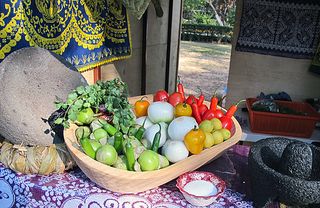
More ingredients and utensils crucial to the regional Michoacán kitchen.
Mexico Cooks! will keep you informed about the dates for the 2012 Ninth Annual Encuentro de Cocina Tradicional de Michoacán.
This unique event, a true look at Michoacán's regional cuisine, should
be on everyone's calendar for early December. Come with us and we will
introduce you to all of these dishes and more!
Looking for a tailored-to-your-interests specialized tour in Mexico? Click here: Tours.
